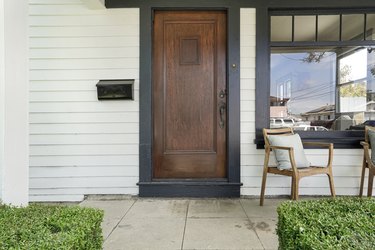
Your home's front door is more than a mere entryway. It tells a story about you, your home and your family. It sets the tone for everything that lies beyond that door – your home, its decor and the way it feels to you and your visitors. Generally, entry doors are made of three different types of material: fiberglass, wood or steel. Each material offers certain advantages and drawbacks, and it's relatively easy to tell one from the other with a little attention.
Pros and Cons of Fiberglass Doors
Video of the Day
Fiberglass is the practical choice for many homeowners, and fiberglass doors may be found in an embossed wood grain finish or in a smoothed texture. Durable fiberglass doors boast superior resistance to everyday wear and tear compared to other door materials and are less susceptible to dents and dings. You can stain or paint them. They're also relatively inexpensive and require less in the way of ongoing maintenance.
Video of the Day
Fiberglass doors can last for many years – even decades. They are also quite energy efficient, offering more insulation than wood doors.
However, fiberglass doors aren't indestructible. They're capable of cracking under severe impact. What's more, the aesthetic value of fiberglass doors, even those painted to look like genuine wood, is questionable to many people who prefer genuine wood.
Pros and Cons of Wood Doors
Wood doors provide the luxury aesthetic that all other materials attempt to emulate. Prized for the superior look and feel provided by the natural wood grain, wood doors are also tops at resisting ordinary wear and tear. If the door does get scratched, you'll find those fairly easy to patch and repair.
Unfortunately, that beauty and sturdiness come at a price. Wood doors are relatively high-priced compared to alternatives. They may also require more frequent upkeep and maintenance to preserve their good looks, including paint and varnish.
Also, wood may not be the most energy-efficient choice. Exposed to heat, light and the elements, wood doors may peel, warp, bubble and otherwise deform. Most of the wood door's limitations are linked with energy efficiency, durability and maintenance.
Distinguishing Fiberglass From Wood
To tell if your door is made of fiberglass or wood, first examine the door's surface and color. Wood doors retain a color that's natural to various types of trees. Even if stained, the color shows through, albeit darker in tone. If the door is painted, you'll have to examine the structure and design of the door more carefully.
Also, feel the surface of the door. A solid wood door's surface will remain smooth due to sanding, while a fiberglass door may have an imprinted texture you can feel.
Next, check out the bottom and sides of your door. If your door is made of wood, then boards had to be cut to fit together and make up your door. Thus, you can see small seams along the door's sides near the top and bottom where the panels were connected together. Fiberglass doors will be free of these seams because they're made from a single panel.
Finally, try knocking on the door's surface. If the door is solid wood, you'll hear a crisp knocking sound. Fiberglass doors are generally filled with foam and thus produce a dampened sound, more like a dull thud.
Another Choice: Steel
Accounting for about half the current entry door market, steel doors are relatively inexpensive while still offering superior security and weather resistance that you'd expect from the costlier wood and fiberglass varieties.
They generally require little maintenance unless small children or pets create dents. As is, they're fairly energy efficient. Glass panels may reduce that efficiency somewhat.
If a door is damaged, it may be harder to repair a steel door than a comparable wood or fiberglass door. In addition, if you don't paint over a scratch quickly, it could end up rusting.